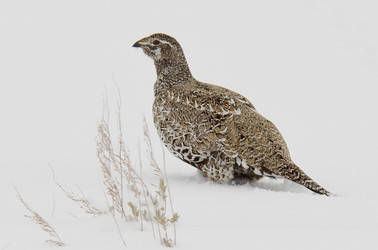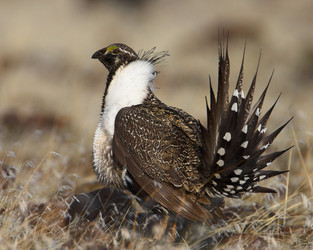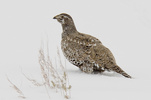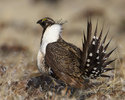Centrocercus



This tree diagram shows the relationships between several groups of organisms.
The root of the current tree connects the organisms featured in this tree to their containing group and the rest of the Tree of Life. The basal branching point in the tree represents the ancestor of the other groups in the tree. This ancestor diversified over time into several descendent subgroups, which are represented as internal nodes and terminal taxa to the right.

You can click on the root to travel down the Tree of Life all the way to the root of all Life, and you can click on the names of descendent subgroups to travel up the Tree of Life all the way to individual species.
For more information on ToL tree formatting, please see Interpreting the Tree or Classification. To learn more about phylogenetic trees, please visit our Phylogenetic Biology pages.
close boxTitle Illustrations

| Scientific Name | Centrocercus urophasianus |
|---|---|
| Location | Wyoming, USA |
| Specimen Condition | Live Specimen |
| Source | Sage Grouse |
| Source Collection | Flickr |
| Image Use |
 This media file is licensed under the Creative Commons Attribution-NonCommercial-NoDerivs License - Version 2.0. This media file is licensed under the Creative Commons Attribution-NonCommercial-NoDerivs License - Version 2.0.
|
| Copyright | © 2011 David Schenfeld |
| Scientific Name | Centrocercus urophasianus |
|---|---|
| Comments | The greater sage-grouse (Centrocercus urophasianus) is a large, ground-dwelling bird. Measuring as much as 30 inches in length and two feet tall, it weighs from two to seven pounds. It has a long, pointed tail with legs feathered to the base of the toes and fleshy yellow combs over the eyes. Males are larger than females and sport a white ruff around their necks in addition to the typical mottled brown, black and white plumage. Distribution and Habitat: The greater sage-grouse is found at elevations ranging from 4,000 to over 9,000 feet. It is an omnivore, eating mainly sagebrush, some other soft plants, and insects. One of the most interesting aspects of the greater sage-grouse is its nearly complete reliance on sagebrush. These birds cannot survive in areas where sagebrush does not exist. The historic range of the greater sage-grouse included Washington, Oregon, California, Nevada, Idaho, Montana, Wyoming, Colorado, Utah, South Dakota, North Dakota, Kansas, Oklahoma, Nebraska, New Mexico, Arizona, and the Canadian provinces of British Columbia, Alberta, and Saskatchewan. Greater sage-grouse have apparently disappeared from Nebraska, Kansas, Oklahoma, New Mexico, Arizona British Columbia and Saskatchewan. Greater sage-grouse that occur in the Bi-State area of eastern California and west central Nevada have been referred to as Mono Basin Area population of sage-grouse by some. The geographic range covered by Mono Basin area population of sage-grouse includes portions of Carson City , Lyon, Mineral, Esmeralda, and Douglas Counties in Nevada and portions of Alpine and Inyo Counties , and most of Mono County , in California . Several studies have documented that greater sage-grouse in this geographic area are genetically unique compared to populations of greater sage-grouse elsewhere in the species range. However, the full extent of this uniqueness is yet to be determined. (USFWS/Stephen Ting) |
| Specimen Condition | Live Specimen |
| Source | Greater Sage Grouse |
| Source Collection | Flickr |
| Image Use |
 This media file is licensed under the Creative Commons Attribution License - Version 2.0. This media file is licensed under the Creative Commons Attribution License - Version 2.0.
|
| Copyright | © 2006 Pacific Southwest Region U.S. Fish and Wildlife Service |
About This Page
Page copyright © 2006
 Page: Tree of Life
Centrocercus.
The TEXT of this page is licensed under the
Creative Commons Attribution-NonCommercial License - Version 3.0. Note that images and other media
featured on this page are each governed by their own license, and they may or may not be available
for reuse. Click on an image or a media link to access the media data window, which provides the
relevant licensing information. For the general terms and conditions of ToL material reuse and
redistribution, please see the Tree of Life Copyright
Policies.
Page: Tree of Life
Centrocercus.
The TEXT of this page is licensed under the
Creative Commons Attribution-NonCommercial License - Version 3.0. Note that images and other media
featured on this page are each governed by their own license, and they may or may not be available
for reuse. Click on an image or a media link to access the media data window, which provides the
relevant licensing information. For the general terms and conditions of ToL material reuse and
redistribution, please see the Tree of Life Copyright
Policies.
- First online 07 March 2007
- Content changed 07 March 2007
Citing this page:
Tree of Life Web Project. 2007. Centrocercus. Version 07 March 2007 (temporary). http://tolweb.org/Centrocercus/57242/2007.03.07 in The Tree of Life Web Project, http://tolweb.org/









 Go to quick links
Go to quick search
Go to navigation for this section of the ToL site
Go to detailed links for the ToL site
Go to quick links
Go to quick search
Go to navigation for this section of the ToL site
Go to detailed links for the ToL site